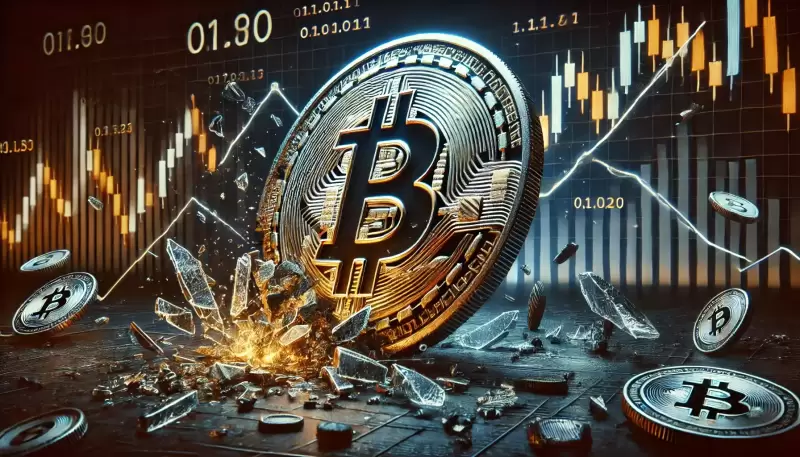 |
|
 |
|
 |
|
 |
|
 |
|
 |
|
 |
|
 |
|
 |
|
 |
|
 |
|
 |
|
 |
|
 |
|
 |
|
Cryptocurrency News Articles
Bitcoin (BTC) Dips Below $83,000, but Derivatives Markets Suggest the Dip Should Be Short-Lived
Mar 05, 2025 at 01:50 am
Bitcoin's (BTC) recent volatility highlights how markets tend to overreact, especially in situations that can escalate, such as trade wars.
Bitcoin (BTC) price dropped below the $83,000 mark on March 3 as the S&P 500 remained in correction territory, with the major U.S. stock market index down 6.5% since its all-time high on Feb. 19.
While a 6.5% drop in the S&P 500 might seem minor in absolute terms, it could have a more significant impact on the potential earnings impact.
However, derivatives markets suggest that Bitcoin’s move below $83,000 should be short-lived.
Chart showing the US 2-year Treasury yield (left) and Bitcoin/USD (right).
Traders tend to sell off assets when they sense a recession coming. Presently, investors are moving into cash and short-term government bonds.
This shift explains why the US 2-year Treasury yield recently hit its lowest level in five months. Traders are willing to accept lower yields, which shows strong buying interest.
Bitcoin derivatives markets held firm despite the 16% correction since the rejection at $99,500 on Feb. 21, indicating that whales and market makers do not expect further declines.
More importantly, even if the much-anticipated United States strategic digital asset reserves fail to secure congressional approval, there is still strong political momentum at the state level, keeping the initiatives alive.
Bitcoin 2-month futures annualized premium. Source: Laevitas.ch
Bitcoin futures maintained a stable 6.5% annualized premium (basis rate) over spot markets as of March 4, unchanged from the prior week. This metric remained within the neutral 5% to 10% range observed over the past four weeks—a clear indication that professional traders are unfazed by recent volatility, showing confidence in market stability.
Bitcoin 30-day options delta skew (put-call). Source: Laevitas.ch
The Bitcoin options 25% delta skew (put-call) stood at 4% on March 4, reflecting balanced pricing between put (sell) and call (buy) options. Given the failed attempt to reclaim the $94,000 support on March 3, the low demand for protective puts signals resilience among investors.
Bitcoin’s dip below $83,000 reflects macroeconomic uncertainty
US Senator Cynthia Lummis predicted that state governments will likely adopt Bitcoin into strategic reserves before the federal government. Utah’s HB230 “Blockchain and Digital Innovation Amendments” bill has already passed the House and, if approved by the Senate, could allocate up to 5% of state reserves to Bitcoin through a qualified custodian or exchange-traded funds (ETFs).
However, Bitcoin’s ability to regain bullish momentum remains closely tied to traditional market sentiment. Traders worry that 20% or greater two-week price drops in companies like Tesla, TSM, Broadcom, and ARM signal that the artificial intelligence sector has entered a bear market, potentially impacting sales of the world’s largest corporations and reducing investor appetite for risk assets.
Investors are worried that US economic growth will slow down, and this seems likely based on the Atlanta Fed’s real GDP estimate. If the US economy contracts by 2% or more in the first quarter, the valuations of publicly listed companies could drop sharply.
At the same time, higher vacancies in commercial real estate could increase credit risks, putting serious pressure on the banking sector.
The recent drop in Bitcoin below $83,000 is not really tied to the success or failure of the US digital asset strategic reserve. Instead, investors are pulling out of riskier assets like artificial intelligence stocks and consumer cyclical companies.
On March 3, spot Bitcoin ETFs saw $74 million in outflows, adding to the uncertainty. Investors worry that institutional demand will remain weak, reflecting a tougher macroeconomic environment.
Chances are Bitcoin’s price will remain below $90,000 until the S&P 500 shows that a normal correction is over—when investors fear a recession, they cut back on risky assets. Still, Bitcoin derivatives data suggests the risk of a bigger drop is low for now.
This article is for general information purposes and is not intended to be and should not be taken as legal or investment advice. The views, thoughts, and opinions expressed here are the author’s alone and do not necessarily reflect or represent the views and opinions of Cointelegraph.
Disclaimer:info@kdj.com
The information provided is not trading advice. kdj.com does not assume any responsibility for any investments made based on the information provided in this article. Cryptocurrencies are highly volatile and it is highly recommended that you invest with caution after thorough research!
If you believe that the content used on this website infringes your copyright, please contact us immediately (info@kdj.com) and we will delete it promptly.
-

-

-

- Countries worldwide have an opportunity to strengthen their positions as financial centres by establishing themselves as hubs for stablecoin transactions
- Apr 04, 2025 at 11:55 pm
- This forward-looking policy would generate significant fee and foreign exchange revenue for financial institutions, ensure proper regulatory oversight of digital currency flows
-

-

-

- Today in XRP news, we have a significant development related to Ripple's role in international payments. By Michael Arrington
- Apr 04, 2025 at 11:50 pm
- In a recent interview, Ripple CEO Brad Garlinghouse clarified how the XRP token can improve and replace the SWIFT system. Additionally, when we compare XRP vs SWIFT, we find significant enhancements which the Ripple payment system can provide.
-

-

-

- Tether's strategic advisor Gabor Gurbacs has taken to his X account to discuss the prospects Bitcoin may have in the next few years.
- Apr 04, 2025 at 11:40 pm
- Gurbacs reminded the crypto community that over the past three years, gold's market capitalization has increased by $10 trillion, and now it stands at $21.173 trillion in total.


























































